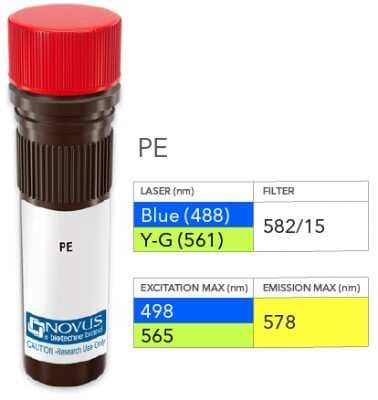TIM-3 Antibody (B8.2C12) [PE]
Novus Biologicals, part of Bio-Techne | Catalog # NBP2-36478PE


Conjugate
Catalog #
Forumulation
Catalog #
Key Product Details
Species Reactivity
Mouse
Applications
CyTOF-ready, Flow Cytometry
Label
PE (Excitation = 488 nm, Emission = 575 nm)
Antibody Source
Monoclonal Rat IgG1 kappa Clone # B8.2C12
Concentration
Please see the vial label for concentration. If unlisted please contact technical services.
Product Specifications
Immunogen
Recombinant mouse TIM-3 protein
Clonality
Monoclonal
Host
Rat
Isotype
IgG1 kappa
Scientific Data Images for TIM-3 Antibody (B8.2C12) [PE]
Product Image: TIM-3 Antibody (B8.2C12) [PE] [NBP2-36478PE] - Vial of PE conjugated antibody. PE has two excitation maxima, 498 nm excited by the Blue laser (488 nm) and 565 nm excited by the Yellow-Green laser (561 nm). Both result in emission at 578 nm.
Applications for TIM-3 Antibody (B8.2C12) [PE]
Application
Recommended Usage
CyTOF-ready
Optimal dilutions of this antibody should be experimentally determined.
Flow Cytometry
Optimal dilutions of this antibody should be experimentally determined.
Application Notes
Optimal dilution of this antibody should be experimentally determined.
Formulation, Preparation, and Storage
Purification
Protein G purified
Formulation
PBS
Preservative
0.05% Sodium Azide
Concentration
Please see the vial label for concentration. If unlisted please contact technical services.
Shipping
The product is shipped with polar packs. Upon receipt, store it immediately at the temperature recommended below.
Stability & Storage
Store at 4C in the dark.
Background: TIM-3
Dysregulation of TIM-3 expression is associated with autoimmune diseases as shown by studies where inhibition of TIM-3 using blocking antibodies worsened disease progression in experimental autoimmune encephalomyelitis (EAE) models of multiple sclerosis (MS) (2,3,5). Conversely, high levels of TIM-3 have been shown during viral infection as well as in many cancer types where its increased expression may be an indicator of poor prognosis (2,3,5). TIM-3 has emerged as a potential cancer immunotherapy target as preclinical studies blocking TIM-3 results in increased anti-tumor immunity and prevents tumor growth (3,5). Studies have suggested combination therapy of TIM-3 blockade with blockade of other checkpoint inhibitors such as programmed death 1 (PD-1) or lymphocyte activation gene 3 (LAG-3) is more effective than TIM-3 blockade alone (3,5).
References
1. Acharya N, Sabatos-Peyton C, Anderson AC. Tim-3 finds its place in the cancer immunotherapy landscape. J Immunother Cancer. 2020; 8(1):e000911. https://doi.org/10.1136/jitc-2020-000911
2. Das M, Zhu C, Kuchroo VK. Tim-3 and its role in regulating anti-tumor immunity. Immunol Rev. 2017; 276(1):97-111. https://doi.org/10.1111/imr.12520
3. Joller N, Kuchroo VK. Tim-3, Lag-3, and TIGIT. Curr Top Microbiol Immunol. 2017; 410:127-156. https://doi.org/10.1007/82_2017_62
4. Uniprot (Q8TDQ0)
5. Wolf Y, Anderson AC, Kuchroo VK. TIM3 comes of age as an inhibitory receptor. Nat Rev Immunol. 2020; 20(3):173-185. https://doi.org/10.1038/s41577-019-0224-6
Long Name
T Cell Immunoglobulin Mucin-3
Alternate Names
CD366, HAVcr-2, HAVCR2, KIM-3, SPTCL, TIM3, TIMD3
Gene Symbol
HAVCR2
Additional TIM-3 Products
Product Documents for TIM-3 Antibody (B8.2C12) [PE]
Product Specific Notices for TIM-3 Antibody (B8.2C12) [PE]
This product is for research use only and is not approved for use in humans or in clinical diagnosis. Primary Antibodies are guaranteed for 1 year from date of receipt.
